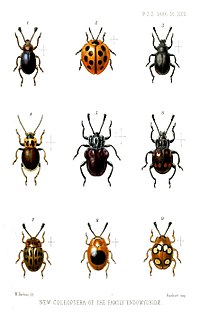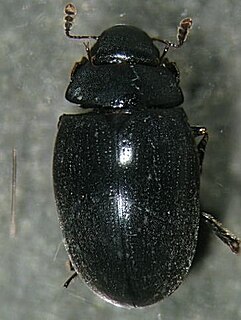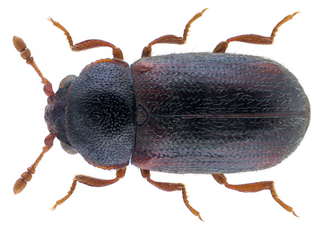
Glaresis is a genus of beetles, sometimes called "enigmatic scarab beetles", in its own family, the Glaresidae. It is closely related to, and was formerly included in, the family Scarabaeidae. Although its members occur in arid and sandy areas worldwide, only the nocturnal adults have ever been collected, and both the larvae and biology of Glaresis are as yet unknown. Due to their narrow habitat associations, a great number of these species occur in extremely limited geographic areas, and are accordingly imperiled by habitat destruction.

Myxophaga is the second-smallest suborder of the Coleoptera after Archostemata, consisting of roughly 65 species of small to minute beetles in four families. The members of this suborder are aquatic and semiaquatic, and feed on algae.

Cucujoidea is a superfamily of beetles. This group formerly included all of the families now included in the superfamily Coccinelloidea. They include some fungus beetles and a diversity of lineages of "bark beetles" unrelated to the "true" bark beetles (Scolytinae), which are weevils.

Endomychidae, or handsome fungus beetles, is a family of beetles with representatives found in all biogeographic realms. There are around 120 genera and 1300 species. The family was established based on the type genus Endomychus, a genus erected in 1795 by Panzer which was applied to a species that Linnaeus called Chrysomela coccinea. As the common name suggests, Endomychidae feed on fungi. Crowson, in his influential treatment of the beetles, placed the family within the Cucujoidea. They have a tarsal formal of 4-4-4 or 3-3-3 and the wings lack a closed radial cell. The second antennal segment has a sensory appendage that is as long as the third antennal segment. The family has also been grouped with the Coccinellidae in a group called the Trimera for having pseudotrimerous tarsi. A 2015 molecular phylogeny study found that the Cucujoidea were found to be non-monophyletic and the Endomychidae was refined with the removal of the Anamorphinae from within the family and elevated to the status of a full family, Anamorphidae. Mycetaeinae and Eupsilobiinae were also found not to belong within the clades of the core Endomychidae, and likewise reclassified into the families Mycetaeidae and Eupsilobiidae.

Jacobsoniidae is a family of Staphylinoidea beetles. The larvae and adults live under bark, in plant litter, fungi, bat guano and rotten wood. It is a small family with 28 described species in three genera:

Nosodendridae is a family of beetles, with only 67 species in three extant genera: Several additional genera and species are known from the fossil record.

Sphindidae is a family of beetles, in the suborder Polyphaga. They are also known as slime mold beetles due to their exclusive feeding on slime molds during adult and larval stages, other aspects of their life history are obscure. Palaeontological discoveries since 2015 have added to the geologic history of Sphindidae, including the discovery of Libanopsis, placed in the extinct subfamily Libanopsinae.

Helotidae is a family of beetles, in the suborder Polyphaga. The family includes about five extant genera, Helota MacLeay, Neohelota Ohta, Afrohelotina Kirejtshuk, Metahelotella Kirejtshuk, and Strophohelota Kirejtshuk. Helotidae are found mainly in the Old World tropics and are absent from Australia and Madagascar. The antennae are clubbed on the final three segments and is retractable within grooves under the head. The wings have reduced venation with just 4 anal veins.

Phloeostichidae is a family of beetles in the superfamily Cucujoidea. There are at least three genera in Phloeostichidae.
The Brachypsectridae are a family of beetles commonly known as the Texas beetles. There are only two extant genera, Brachypsectra and Asiopsectra. The type species, Brachypsectra fulva, occurs in North America. Other species in the genus have a cosmopolitan distribution. Two other extant and fossil species have been described from the Dominican Republic. While formerly considered monogeneric, in 2016 Asiopsectra was described from specimens found in Iran and Tajikistan. Two extinct genera, Vetubrachypsectra and Hongipsectra, known from adults, and a larval genus, Cretopsectra are known from Cenomanian aged Burmese amber.

Omma is a genus of beetles in the family Ommatidae. Omma is an example of a living fossil. The oldest species known, O. liassicum, lived during the final stage of the Triassic (Rhaetian), over 200 million years ago, though the placement of this species in Omma has been questioned. Numerous other fossil species are known from the Jurassic and Cretaceous of Europe and Asia. The only living species is Omma stanleyi, which is endemic to Australia. Three other extant species endemic to Australia that were formerly part of this genus were moved to the separate genus Beutelius in 2020.Omma stanleyi is strongly associated with wood, being found under Eucalyptus bark and exhibiting thanatosis when disturbed. Its larval stage and many other life details are unknown due to its rarity. Males are typically 14-20 mm in length, while females are 14.4-27.5 mm. Omma stanleyi occurs throughout eastern Australia from Victoria to Central Queensland.

Monotomidae is a family of beetles in the suborder Polyphaga, containing the following genera:

Eucnemidae, or false click beetles, are a family of polyphagan beetles including about 1700 species distributed worldwide.

Clambidae is a family of beetles. They are known commonly as the minute beetles or the fringe-winged beetles. They are found worldwide on every continent except Antarctica.
Derolathrus is a genus of Jacobson's beetles in the family Jacobsoniidae. There are 11 described species in Derolathrus.

Cyclaxyridae are a family of beetles in the superfamily Cucujoidea. The only living genus is Cyclaxyra, with two species endemic to New Zealand. Other species have been named from fossils. They are also known as sooty mould beetles due to the association of Cyclaxyra with sooty mould. The extant species are mycophagous, feeding on spores, conidia, and hyphae.
2017 in paleoentomology is a list of new fossil insect taxa that were described during the year 2017, as well as other significant discoveries and events related to paleoentomology that were scheduled to occur during the year.
Echinocups is an extinct genus of Ommatine beetle. It was created in 2020 to house three species originally assigned to Notocupes, E. denticollis, E. neli and E. ohmkuhnlei The genus name refers to the sharp spikes present on the elytra. All three species are known from the Cenomanian aged Burmese amber of Myanmar.
Burmese amber is fossil resin dating to the early Late Cretaceous Cenomanian age recovered from deposits in the Hukawng Valley of northern Myanmar. It is known for being one of the most diverse Cretaceous age amber paleobiotas, containing rich arthropod fossils, along with uncommon vertebrate fossils and even rare marine inclusions. A mostly complete list of all taxa described up until 2018 can be found in Ross 2018; its supplement Ross 2019b covers most of 2019.
Acalyptomerus asiaticus, is a species of fringe-winged beetle found in India, Sri Lanka, Malaysia and Thailand. It is also introduced to Jamaica.













